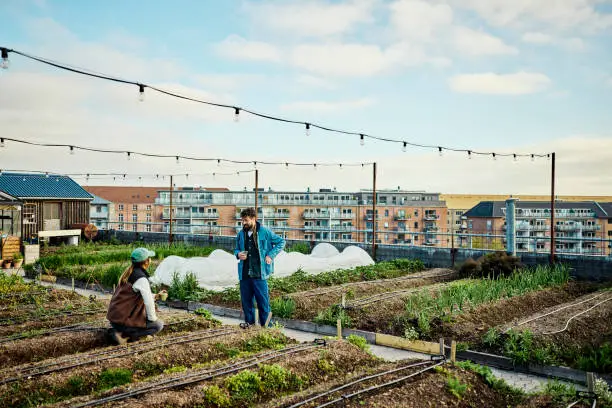Urban farming is a growing movement that allows city dwellers to cultivate fresh produce, herbs, and even raise small livestock in limited urban spaces. Whether you have a small balcony, a rooftop, or a tiny backyard, urban farming can help you grow your food, reduce your carbon footprint, and connect with nature. Here’s a step-by-step guide on how to do urban farming.
Assess Your Space and Environment
Before you start, evaluate the space you have available and the environmental conditions:
Identify Your Space
Determine the available space for farming, such as a balcony, rooftop, backyard, windowsill, or even a community garden. The space will influence what and how much you can grow.
Check Sunlight Exposure
Most edible plants require at least 6 hours of sunlight per day. Observe how much sunlight your space receives to decide which crops will thrive.
Consider Water Access
Ensure you have easy access to water, as regular watering is crucial for plant growth. If water is limited, consider installing a rainwater harvesting system or using a drip irrigation system.
Choose What to Grow
Select crops that are suitable for your space, climate, and personal preferences:
Start with Easy-to-Grow Plants
For beginners, start with plants that are easy to grow and maintain, such as herbs (basil, mint, parsley), leafy greens (lettuce, spinach, kale), and root vegetables (radishes, carrots).
Grow According to Season
Choose crops that are appropriate for your local climate and growing season. Research what grows best in your region during different times of the year.
Consider Vertical Gardening
If space is limited, consider growing vertically by using trellises, hanging baskets, or vertical garden systems. This method works well for crops like tomatoes, cucumbers, and beans.
Select the Right Containers and Soil
Proper containers and soil are essential for successful urban farming:
Choose Containers
Depending on your space, you can use pots, raised beds, grow bags, or repurposed containers like old buckets or wooden crates. Make sure the containers have drainage holes to prevent waterlogging.
Select the Right Soil
Use high-quality potting soil or a mix of compost, peat, and perlite for good drainage and nutrient retention. Avoid using garden soil, as it may be too heavy and compacted for container gardening.
Add Fertilizer
Urban farming often requires supplementing the soil with fertilizers. Organic options like compost, worm castings, or fish emulsion provide essential nutrients without harming the environment.
Plant Your Crops
Once you have your containers and soil ready, it’s time to plant:
Start from Seeds or Seedlings
You can either start your plants from seeds or purchase seedlings from a nursery. Starting from seeds is more economical, but seedlings give you a head start.
Follow Planting Guidelines
Each plant has specific requirements for planting depth, spacing, and care. Follow the guidelines on seed packets or plant labels for the best results.
Companion Planting
Consider companion planting, where certain plants are grown together to benefit each other. For example, planting basil near tomatoes can improve the flavor and repel pests.
Water and Maintain Your Garden
Regular maintenance is key to a healthy urban farm:
Water Consistently
Most urban farms need regular watering, especially in hot weather. Water your plants early in the morning or late in the evening to reduce evaporation. Consider using a watering can with a fine spout or a drip irrigation system for even distribution.
Prune and Harvest
Regularly prune your plants to encourage growth and remove any dead or diseased leaves. Harvest crops as they mature to enjoy fresh produce and encourage continuous growth.
Monitor for Pests and Diseases
Keep an eye out for pests and diseases, which can quickly spread in small urban spaces. Use organic pest control methods like neem oil, insecticidal soap, or introducing beneficial insects like ladybugs.
Composting and Soil Health
Maintaining soil health is essential for long-term urban farming success:
Start Composting
Composting kitchen scraps like vegetable peels, coffee grounds, and eggshells can provide rich organic matter for your soil. You can use a small compost bin or a worm composting system (vermicomposting) in your urban space.
Rotate Crops
If you have multiple planting seasons, rotate your crops to prevent soil depletion and reduce the risk of pests and diseases.
Expand Your Urban Farm
As you gain confidence, consider expanding your urban farm:
Try Advanced Techniques
Experiment with hydroponics (growing plants in nutrient-rich water) or aquaponics (combining fish farming with plant cultivation) if you have the space and resources.
Grow Perennial Plants
Consider adding perennial plants like fruit trees, berry bushes, or herbs that come back year after year, reducing the need for replanting.
Also Read: How To Decorate A Bedsitter



